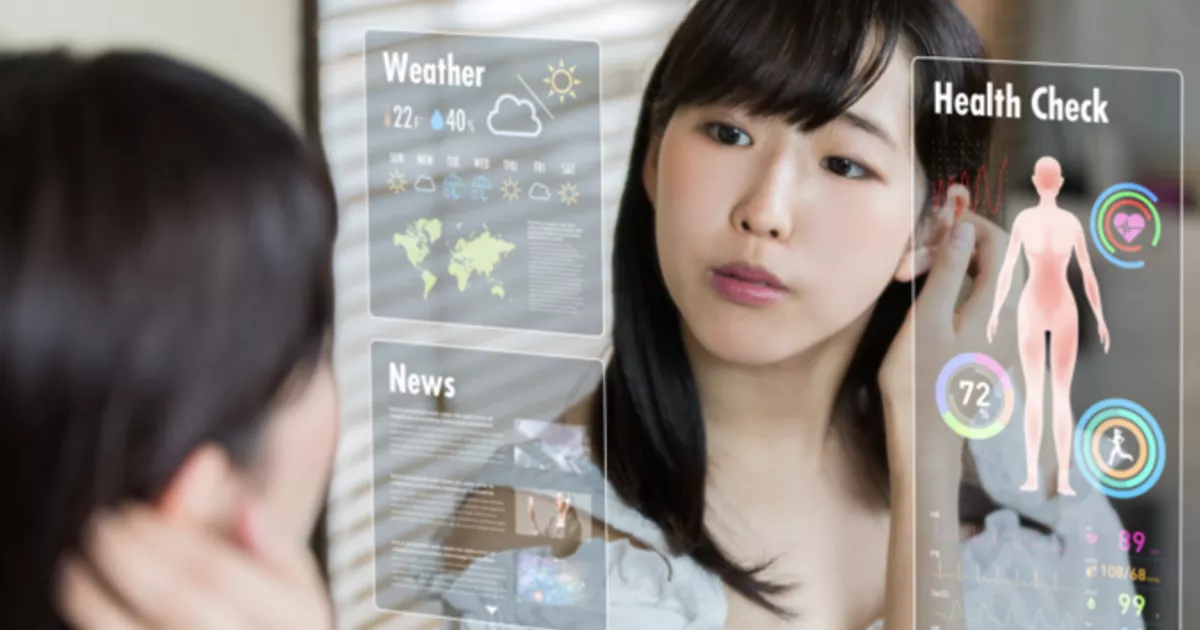It seems like artificial intelligence is being used to predict everything at the moment – from sex positions we'll be doing in the future to what hair trends we'll be rocking next year.
And now online bathroom specialists Big Bathroom Shop have asked the AI-powered language model ChatGPT to predict what bathrooms will look like in 2033.
And it seems like it'll be much fancier than your average loo and taps right now.
READ MORE: World's first generative AI tech allows Tinder users to pimp up dating profiles
The data has revealed 10 drivers and features that could be expected to reshape the room.

However, it seems virtual reality relaxation is supposed to be one of the biggest.
According to the company, bathroom could become spaces for relaxation and escapism, incorporating VR technology to provide immersive experiences like virtual beach scenes or calming landscapes.
Using internal sales data and industry expertise, Rikki Fothergill, bathroom trends analyst at Big Bathroom Shop, has weighed in on which features she believes are most likely to prove influential when it comes to bathroom design in 2033.
Rikki comments: “In the ever-evolving landscape of technology, one living space that has already experienced a significant surge in the realm of smart products is the bathroom.

"It’s clear that these innovative additions are reshaping the way we experience and interact with this room. Some of the latest smart products within the bathroom industry include smart leak detectors, smart showers, and smart toilets that can all be controlled through phones and iPads to enhance the overall functionality. With a click of a button, you can command your showers temperature, the music and lighting.
“This coordination exemplifies the direction in which bathroom technology is headed. Hence our increase in demand for smart showers and Japanese toilets.”
On space efficiency, he added: “The concept of space efficiency has always been a dominant trend. The limited square footage of many UK bathrooms has spurred a need for creative solutions that optimise every inch of space. So, in a post COVID era that sees bathrooms switching from utilitarian spaces to extensions of personal style and comfort, the challenge lies in accommodating our desire for both luxury and functionality in continuously shrinking rooms.

“This has prompted a shift towards reimaging bathroom layouts and incorporating innovative storage solutions amongst our consumers and we only expect this to continue.”
Talking about health and wellness, he also said: “As the fast-paced modern world expands, our pursuit for wellness has never been more crucial. Beyond the traditional realms of nutrition and exercise, wellness now extends into our living spaces and particularly, our bathrooms.
"Although the bathroom industry may not be rolling out personalised body-monitoring programmes in the next 10 years, new product development will definitely play into other areas of wellness such as colour and aesthetics.
“5-10 years ago neutrals were the go-to colour scheme, now people want to create a space that is completely their own sanctuary. There is an ongoing surge in colours like royal blues and evergreen hues, as well as biophilic features as they are known for their calming qualities.”
But what other elements could we expect to see in the bathroom of the future?
Based on current trends and emerging technologies, below are the nine other elements you can expect to find in AI’s bathroom of the future.
1. Smart Fixtures
Bathrooms will feature smart fixtures such as toilets, faucets, and showers that can be voice-activated or controlled through wearable devices to offer personalised settings for water temperature, pressure, and aromatherapy
2. Augmented Reality (AR) Mirrors
Mirrors will incorporate AR technology to provide real-time information, such as weather updates, daily schedules, beauty tips as well as assist with virtual trying-on.
3. Hygiene and Health Monitoring
Built-in health monitoring devices will make a feature in bathrooms, analysing urine and stool samples for early signs of health issues, all connectable to wearable tech.
4. Sustainability
Bathrooms are set to have water-saving technologies, like advanced water filtration systems, low-flow fixtures, and even water recycling mechanisms.
5. Personalised Spa Experiences
Bathrooms could mimic spa environments, with advanced lighting systems, soothing sounds, and programmable aromatherapy options, offering a personalised relaxation experience.
6. Advanced 3D Printing
3-D printing technology will be used to create custom-designed bathroom fixtures and accessories, allowing homeowners to tailor their bathrooms to their preferences.
7. Space Efficiency
Given the growing population and urbanisation, bathrooms will be designed with space optimisation in mind, incorporating foldable or modular elements to maximise utility in smaller living spaces.
8. Health and Wellness Integration
Bathrooms could seamlessly integrate with health and wellness apps, providing real-time data on hygiene routines, skincare, and other health-related activities.
9. Energy Efficiency
Energy-efficient lighting and ventilation systems will help towards reducing overall energy consumption.
Source: Read Full Article
